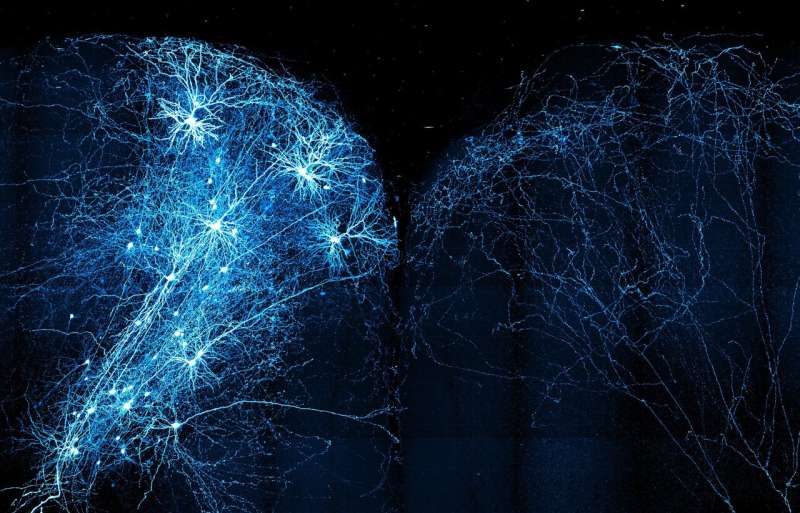MouseLight project maps 1,000 neurons (and counting) in the mouse brain

Scientists are batting a thousand in a project to reconstruct the mouse brain's wiring diagram.
Researchers at the Howard Hughes Medical Institute's Janelia Research Campus have now carefully unraveled a tangle of more than 1,000 neurons, tracing each cell's branching route across the brain to pinpoint where it goes and to which cells it connects. If laid end-to-end, the neurons would stretch more than 80 meters, roughly the length of two school buses, the team reports September 5, 2019, in the journal Cell.
When Jayaram Chandrashekar and his colleagues began their neural cartography effort two years ago, neuroscientists had a general idea about which areas of the mammalian brain talked to one other. But what the messaging infrastructure actually looked like was largely a mystery. A fleshed-out picture of that circuitry could help scientists better understand how the brain is wired and how messages travel through it. In October 2017, the neuron-tracing project team, called MouseLight, released data for the first 300 neurons. Now, they've vastly expanded the data set, adding over 700 more to the collection.
"It's by far the largest digital collection of such neurons," says Chandrashekar.
Over time, the team has streamlined their neuron-tracing process. First, the team injects a virus into mouse brains that makes a handful of neurons glow. Then, they use a light microscope to capture high-resolution images of the illuminated neurons. A computer program stitches together the 20,000 resulting images to make a three-dimensional map of the brain. "It's like putting together 20,000 Lego blocks," Chandrashekar says. Algorithms and software developed in collaboration with Janelia's Scientific Computing group then help scientists follow the intertwined paths of individual neurons. Currently, it takes about one day to trace a single neuron, but a few years ago, it took a week or two.
The preliminary data are revealing new clues about how the mouse brain is wired. In some regions, neurons cluster into discrete categories. In other regions, neurons can't be easily delineated into specific types. What that means for the way messages travel around the brain isn't yet clear, Chandrashekar says, but it's a target for future research.
Still, much of the mouse brain, which contains about 70 million neurons, remains uncharted wilderness. For even a fuzzy view of the whole brain's wiring scheme to emerge—the equivalent of a tourist map that captures major landmarks—you'd need to trace about 100,000 neurons, estimates Janelia Group Leader Karel Svoboda.
So far, MouseLight has focused on reconstructing neurons in a few areas of the brain that Janelia scientists are studying: the motor cortex, the subiculum, the hypothalamus, and the thalamus. For example, Svoboda has used MouseLight data to identify distinct motor control pathways in mice.
The project is still growing, though. The MouseLight team has shared their ever-expanding data set online, and Chandrashekar hopes that other scientists will join their neuron-tracing efforts.
More information: Johan Winnubst, Erhan Bas, Tiago A. Ferreira, Zhuhao Wu, Michael N. Economo, Patrick Edson, Ben J. Arthur, Christopher Bruns, Konrad Rokicki, David Schauder, Donald J. Olbris, Sean D. Murphy, David G. Ackerman, Cameron Arshadi, Perry Baldwin, Regina Blake, Ahmad Elsayed, Mashtura Hasan, Daniel Ramirez, Bruno Dos Santos, Monet Weldon, Amina Zafar, Joshua T. Dudmann, Charles R. Gerfen, Adam W. Hantman, Wyatt Korff, Scott M. Sternson, Nelson Spruston, Karel Svoboda, Jayaram Chandrashekar, "Reconstruction of 1,000 projection neurons reveals new cell types and organization of long-range connectivity in the mouse brain." Cell. Published online September 5, 2019. DOI: 10.1016/j.cell.2019.07.042



















